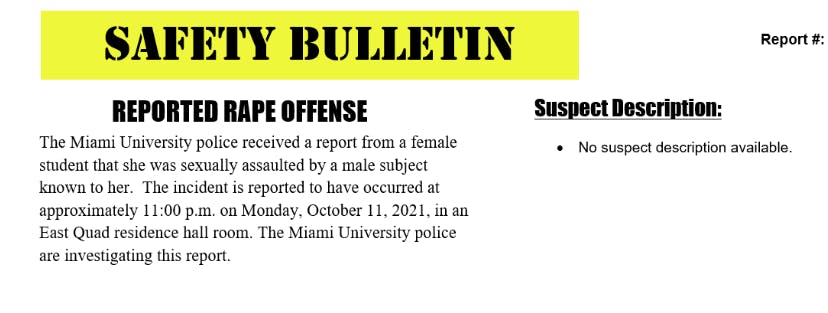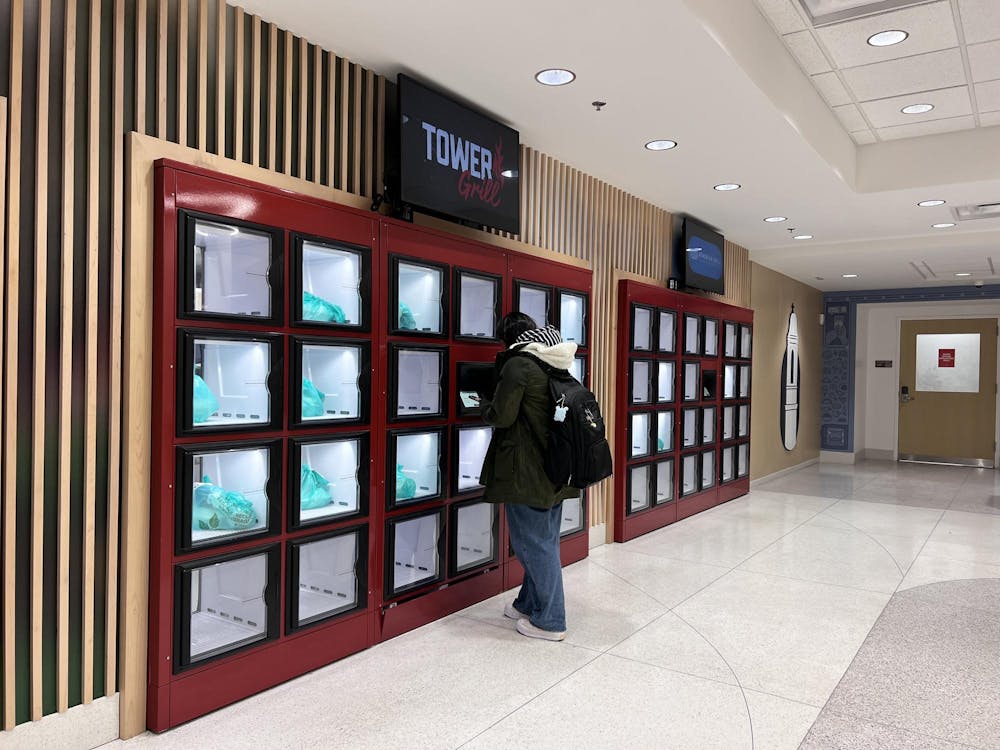If, one day, my daughter comes to me and says she wants to go to Miami University, I will tell her I have many amazing memories of my time there. I will recall how much I loved my classes. I will regale her with my stories of hockey games, late night debates and the beautiful campus that changes with the seasons.
I will also share with her the darker side of Miami. I will warn my daughter of the dangers of men who take advantage of young women, especially those who are inebriated. I will tell her about the record number of sexual violence reports I received in my email my freshman year, and I will tell her the many stories I heard from girls who did not report.
I will spare her no details, for I want her to be afraid.
Because I was afraid many times. Every time I saw a “Safety Bulletin” from the Miami Police I wondered about the details beyond where the rape took place or if the suspect was known by the victim. Flashbacks of stories I had heard would come to mind, and I couldn’t help but to fill in the gaps the emails left out.
It felt like every week I received a bulletin about a sexual assault case on campus, scarce with details and never a follow-up.

The topic became normalized, but simplified. Made appropriate for school. Orientation addressed this subject by displaying their defense mechanism installed on campus, the blue light system, which provided students an alert system against a late-night shadow attacker…
There was a wide variety of attacks, and the numbers varied in a pattern that followed the seasons. Of all the stories I have heard, most did not include shadow figures, no unrecognizable attacker. The cops involved sounded scary and intimidating. The incidents themselves even varied in degree of violence. Environments supposedly meant for student fun were hostile — many times I could almost feel danger in the air. The only common variable was the victim always lost, and the perpetrator almost always got off.
So what happens when my daughter wants to know more and does her own research after this conversation? Will she find anything resembling the horror her mother just described? What if she wants to know what her reality would be like after such attacks? What if she wonders how the college will help her?
Freshman year is full of sexual assault prevention lectures. Miami often presents workshops on alcohol safety and sexual assault education. Freshman orientation included student-performed scenes that demonstrated the warning signs of sexual assaults. Additionally, my sorority initiation included countless sessions that bolstered my early education on these issues.
Despite these efforts, students usually fail to take these procedures seriously. Students around me laughed at the plays or complained about the endless workshops. As someone victimized by sexual assault, I hardly saw these experiences as comforting and I was suspicious about their efficacy in prevention.
Enjoy what you're reading?
Signup for our newsletter
Now that we are in a post-Roe v. Wade era, we cannot afford to continue to dismiss impunity for attackers in sexual assault cases. Now that women have lost full autonomy over their own bodies, change needs to happen before we send another generation of girls unprotected into the same society that turns a blind eye to sexual violence.
My suspicion of Miami’s effort to end rape culture at their university grew to anger throughout my time at Miami. Every sexual assault report email added gas to the fire inside my chest. My eyes burned every time I heard a friend share their story. The feeling of helplessness grew when I watched the violent acts girls faced: being chased home late at night, pushed to the ground while waiting in line for Uptown restaurants and even pushed down the stairs by frat boyfriends. Girls on and off campus are enduring aggression.
This is not only a Miami problem. According to the National Campus Sexual Assualt Study, 26.4% of college women are sexually assaulted. College women are also 20% less likely than non-student females to be sexually assaulted — a heavy fact noting that Miami reported 42 sexual assault cases in the year 2019 alone.
The Miami Student has over 500 search results for sexual assault stories, and each case seems to stay in a status of “pending” until it is gone from our memories. But the aftershocks are visible. The investigations at Dartmouth College are a perfect example of what happens when these cases get swept under the rug. The school was aware of professors’ inappropriate behavior for 16 years and did nothing, leaving students vulnerable. Still, the professors left the school without punishment and the case ended with a $14 million settlement in which the university took no fault.
Case after case, stories make the news but are never followed up, or the criminal gets off easy. As a student whose discipline is based on research, I struggle to find free public records of case results in all of the stories I come across. I encourage you to try and find these final details too.
For instance, where is Miami alum Antonio Charles today? Charles admitted to engaging in sexual activity with an intoxicated Junior named Amy in 2011. The case was “EXCEPTIONALLY cleared” because it could not be proven force was used, or in other words, a rape kit was not done within the 72-96 hours’ limit.
Why is force the main focus here?
Sharon Block’s Rape and Sexual Power in Early America sums up the insanity of America’s old rape laws.
During the 19th century, women victims had a long list of expectations to remain creditable. Interrogations went as; “where did the crime happen?”, “was there anyone in earshot of you?”, “did you testify immediately after and show your injuries?”, “How hard did you fight back?”
Rape has been defined and redefined by men throughout history. When women claimed rape, they were guilty until proven the victim. The constitution did not protect them. Though rape was always thought among the top cruelest crimes, the accusation is viewed as a more dangerous threat.
Why were an admission, a city-wide reputation and multiple similar female stories not enough to bring forth justice for Amy?
The training modules given to students focus on consent and what that means, but in the courtroom, a victim’s honor is determined by the brutality of their attack and judged by their self-defense response. If that is true, then I make an argument that America is no better than it was when women and non-whites were not considered citizens.
The already difficult decision to report and get justice is only worsened when the reporting girls are treated unnecessarily harshly. In Amy’s experience reporting to the police after a sexual assault, their main concern was why she put herself in a sketchy situation and if she understood the seriousness of her accusations.
Simply receiving help for mental health has been known to be difficult at Miami, which just recently received more funding. But back in 2019, students were still experiencing difficulties with counseling help even when there was available specialized staff.
School, work and general well-being do not go on hold while young adults get a handle on their situation and decide on legal action. No matter how many times you are “trained” on how to respond to a sexual assault, no student should be expected to be put in these situations.
There are infinite numbers of reasons someone may not report. Getting a rape kit has to be done fast but, it can be traumatizing. Speaking about your experience and becoming vulnerable to the public’s eye is not easy. Choosing legal action and having to defend yourself in a court of law is not cheap.
Miami, like other universities, developed a reporting system to facilitate notifications about these assaults. But, across the board, nothing seems to exist about the case timeline or outcomes.
Meanwhile, these young women remain vulnerable in an environment that has allowed more violence to proliferate. Why should girls feel confident in their reports when often no repercussions come from it?
Without a holistic take on the aftercare of victims, data can’t be collected, and survivors' mental health will suffer. This does not ensure a safe learning and living environment as required by Title IX.
Equal learning opportunities require quality of living; A safe space to mentally heal from sexual trauma to allow for the student to fully focus and engage with their school work, not only in the classroom, but at home, as expected by the teacher.
A junior at Miami took it upon himself to right the wrong his housemate committed after learning that the housemate had raped a girl. The student got two friends of his to report the incident along with him. The assaulter was in such a dangerous mental space that the student retreated home for the rest of the semester.
The horror of the story stuck with me… I felt sick and unable to forget about what happened.
When the next school year came, I asked what happened to the old housemate. It turned out that he’s still walking the brick streets of Miami as if nothing happened.
The student shared awareness the best he could. There were many witnesses to the assaulter’s alarming behavior. Multiple reports were sent to the school, but when I type in his name on the internet today, all I see is his LinkedIn, which reads, “employee of Miami University and about to graduate from Farmer School of Business.”
The details of this incident were disturbing. This boy should not have slipped through the system. How many of these unknown cases happen? Or other ones where students must sit in class with a staff member who had assaulted them as they wait for the trial to validate their pain, or deliver justice?
The public is unaware of crimes committed by students who still attend the school parents send their kids to. Evidence of this case remains hidden, like so many others. The first step in self-defense is awareness of danger. Miami’s website page seems to provide that information in a calculated way. The page refers to the 2017 Sexual Assault Campus Climate Survey, a survey taken by a quarter of Miami’s full-time Oxford Campus undergraduate students regarding sexual assault experiences during their time at Miami.
The survey found that 13% of reported sexual and interpersonal violence happened away from campus, “a critical reminder that sexual and interpersonal violence is experienced by our students not just within our campus community but in their home communities as well.”
This quote sounds to me like blame being passed on, ignoring all the problems that go on Uptown. The repetitive use of the word “campus” as if off-campus students or students who attend regional campuses are not part of the community. This quote follows a reminder: the 2015 survey asks for the previous 12 months, meaning the numbers are low.
The prevalence chart first lists the statistic for “nonvictim.” I was confused as to why this was there or what it meant. The page states, “the 26.5% Victimization rate is said to be similar to other colleges nationally” as if that sounds like a good thing. And of course, Miami compared numbers to those of Ohio University. Under the school’s definition of stalking, harassment and intimate partner violence, Miami scored lower than OU in all but non-consensual sexual contact.
“The statistics reveal only the most significant or most serious reported experience, irrespective of whether there were multiple infractions and/or occasions.”
The school adds this quote as an attempt to calm our nerves. These statistics do not reflect the total number of experiences, but only the most violent and serious. What is considered a “non-serious rape”? Why should being raped multiple times only get marked as once?
I do not want to be calm. I do not think we should be calm. Because even with 79% reported “consent trained students,” the numbers are still rising.
In these moments, the assaulter is not the only one to steal the victim’s voice. Institutions inhibit her ability to openly talk about her suffering and hide her away in numbers instead of providing clear explanations of how these young women received redress. In a society where victim rates rise while criminals walk free, our nation shies away from this “inappropriate” conversation, leaving girls with only the strangers they meet through trauma, like a counselor, with whom to talk through such heart-wrenching experiences.
What Miami is doing is not enough. Lectures on consent are not enough. Societal problems like rape are not easily solved. These vicious acts cannot be ignored. Instead we must shine a light on the problem.
Institutions of authority that claim to protect us must take strong steps to alleviate this violence. The responsibility falls onto the whole town. This includes bars checking cameras and banning people who are caught spiking drinks. More lights for Uptown sidewalks. Not locking the back door of dorms after midnight. A full toxicology screen should be advised by staff for girls who are sent to the hospital after social events to see if they were inebriated or if someone had spiked their drink. That would help defend them in court. Academic accommodations following assaults for the victims, and dismissing tenure rights in the face of sexual assault allegations against staff.
Additionally, conversations revolving around sexual assault experiences should be normalized.
This is the reality students face. This is the story of Miami and the story of our nation. Girls and boys should be able to share their experiences, including uncomfortable details, to uncover the brutal trauma that sexual assault victims endure.




